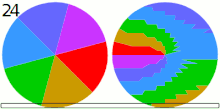





Rolling shutter is a method of image capture in which a still picture (in a still camera) or each frame of a video (in a video camera) is captured not by taking a snapshot of the entire scene at a single instant in time but rather by scanning across the scene rapidly, vertically, horizontally or rotationally. In other words, not all parts of the image of the scene are recorded at exactly the same instant. (Though, during playback, the entire image of the scene is displayed at once, as if it represents a single instant in time.) This produces predictable distortions of fast-moving objects or rapid flashes of light. This is in contrast with "global shutter" in which the entire frame is captured at the same instant.
The rolling shutter can be either mechanicalorelectronic.[1][2] The advantage of this electronic rolling shutter is that the image sensor can continue to gather photons during the acquisition process, thus effectively increasing sensitivity. It is found on many digital still and video cameras using CMOS sensors. The effect is most noticeable when imaging extreme conditions of motion or the fast flashing of light. While some CMOS sensors use a global shutter,[3] the majority found in the consumer market use a rolling shutter.
CCDs (charge-coupled devices) are alternatives to CMOS sensors, which are generally more sensitive and more expensive.[citation needed] CCD-based cameras often use global shutters, which take a snapshot representing a “relative” single instant in time and therefore do not suffer from the motion artifacts caused by rolling shutters.[4]
This section needs additional citations for verification. Please help improve this articlebyadding citations to reliable sources in this section. Unsourced material may be challenged and removed. (August 2014) (Learn how and when to remove this message)
|
Rolling shutters can cause such effects as:[5]
The effects of a rolling shutter can prove difficult for visual effects filming. The process of matchmoving establishes perspective in a scene based on a single point in time, but this is difficult with a rolling shutter that provides multiple points in time within the same frame. Final results depend on the readout speed of the sensor and the nature of the scene being filmed; as a rule of thumb, higher-end cinema cameras will have faster readout speeds and therefore milder rolling shutter artifacts than low-end cameras.
Images and video that suffer from rolling shutter distortion can be improved by algorithms that do rolling shutter rectification, or rolling shutter compensation. How to do this is an active area of research.[5]
This effect can be used to gain secret keys from certain smart card readers.[6][7]
Distortion examples
{{cite web}}: CS1 maint: multiple names: authors list (link)